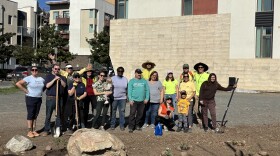A spike in illegal tunnels found along the U.S.-Mexico border coincided with a period of record construction on border walls and fences, according to U.S. Customs and Border Protection records obtained by KPBS.
In 2006, the year the Secure Fence Act was passed, the number of illegal tunnels found along the U.S.-Mexico border more than tripled to 18 and remained in the double digits through 2012. During that same six-year period, the U.S. built an unprecedented 580 miles of border barriers.
The U.S. first started finding these tunnels in the 1990s. That decade, border security initiatives like Operation Gatekeeper in San Diego and Operation Hold The Line in El Paso triggered the construction of dozens of new miles of border walls and fences around those cities. The first illegal cross-border tunnels were found in those cities.
U.S. Customs and Border Protection released historical data on illegal cross-border tunnels in response to repeated Freedom of Information Act requests from KPBS.

David Shirk, a professor at the University of San Diego who studies cross-border criminal organizations, said the data shows that walls and fences do not actually stop the illegal flow of drugs and people into the U.S.
“The reality is, drug tunnels are an illustration of why border walls don't work," Shirk said. "The wall simply ensures that there will be ever more creative ways of getting around it."
Joshua Wilson, vice president of the National Border Patrol Council, argued that walls and fences do stop smuggling. He said cross-border tunnels are an issue primarily in border regions with good soil conditions and nearby warehouses to disguise tunnel entry and exit points, like in Otay Mesa.

Cross-border tunnels have been getting increasingly sophisticated, with electricity and railways, as well as harder to detect: smaller and deeper, sometimes more than 90 feet underground.
Existing tunnel detection technology — ranging from ground-penetrating radar to sensors that detect shifting microgravity — gets thrown off by surface clutter and noise, radio and electromagnetic interference and heterogeneous geology.







